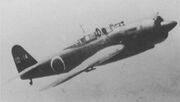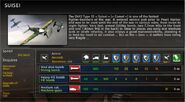Not to be confused with the Susie recon plane, the Yokosuka D4Y Suisei (彗星, "Comet") is Japan's fighter-bomber. Standard in most regards, it is not easily produced in great numbers, and does not have the firepower of other fighter-bombers such as the Typhoon or Sturmovik. Although they are good for routing medium armor, do not plan to use these planes for defense against well armored opponents. Similarly, the Suisei is very vulnerable to fighters, so the user should be sure to escort them with the Zero or the Shinden.
History[]
Development of the aircraft began in 1938 at the Yokosuka Naval Air Technical Arsenal as a carrier-based dive bomber to replace the Aichi D3A.

The first D4Y1 prototype made its maiden flight in December 1940. After the prototype's successful trials, development continued, and the first problems appeared. During dive-bombing trials, the wings of the D4Y started to flutter, a fatal flaw for an airframe subject to the stresses of dive bombing. Because of this, initial production aircraft were used as reconnaissance aircraft, as the D4Y1-C, which took advantage of its high speed and long range, while not over-stressing the airframe. Production of the D4Y1-C continued in small numbers until March 1943, when the increasing losses incurred by the D3A resulted in production switching to the D4Y1 dive-bomber, the aircraft's structural problems finally being solved. Although the D4Y could operate successfully from the large and fast fleet carriers that formed the core of the Combined Fleet at the start of the war, it had problems operating from the smaller and slower carriers such as the Hiyō class which formed a large proportion of Japan's carrier fleet after the losses received in the Battle of Midway. Catapult equipment was therefore fitted, giving rise to the D4Y-1 Kai (or improved) model.
These early versions of the D4Y were difficult to keep in service because the Atsuta engines were unreliable and difficult to maintain in front-line service. From the beginning, some had argued that the D4Y should be powered by an air-cooled radial engine, a type Japanese engineers - and maintenance crew - had experience with and trusted. The aircraft was therefore fitted with the reliable Mitsubishi MK8P Kinsei 62, a 14-cylinder two-row radial engine. This version was the Yokosuka D4Y3 Model 33. A total of 2038 models (all variants) were produced by the end of the war.
Lacking armor and self-sealing fuel tanks, the Suiseis did not do well against Allied fighters. They did, however, cause considerable damage to ships, including the carrier USS Franklin, which was nearly sunk by a single D4Y. The D4Y was operated from the following Japanese aircraft carriers: Chitose, Chiyoda, Hiyō, Junyō, Shinyo, Shōkaku, Sōryū, Taihō, Unryū, Unyō and Zuikaku. The D4Y1-C reconnaissance aircraft entered service in mid-1942, when two of these aircraft were deployed aboard Sōryū at the Battle of Midway, where both were lost when Sōryū was sunk.
The D4Y performed the last Japanese action in WW2. Ten Judys went out to suicide attack any American ships spotted on the 15th of Aug. 1945. Three returned with engine issues, but all of the rest crashed.
Strategy[]
This section is a stub, so be patient and expand it.
Pros & Cons[]
+For a plane with 2 MGs and one rearwards, the dps is excellent, even for dealing with other planes.
+they have the stats of the Zero, just slower.
-The planes are somewhat expensive and require development. Other useful planes could have had the role.
- Kawasaki Ki-102 - much heavier armament and twin engine, a better candidate for the given role.
- The naming of the plane rather than "D4Y" can easily get it confused with the Susie recon plane.
-It's the plane with the weakest bombload. Other planes might compensate by being better against building or vehicles, this one does neither.
Weapons[]
The Suisei has two 7.7mm guns in the nose and a 7.7mm firing rearward. A 500kg bomb for attack runs against the enemy and their facilities, and a 800kg bomb for suicide attacks. There is also (In the real conflict) a nightfighter scouting-type version that has a 20mm defensive cannon facing straight up. The purpose of this weapon was also strictly used for to blow the abilities and durability off of the B29.
| Weapon | ||||||||||
|---|---|---|---|---|---|---|---|---|---|---|
Med. dive bomb |
660 | 110 | 55 | 44 | 26 | 18 | 0m |
| Weapon | ||||||||||
|---|---|---|---|---|---|---|---|---|---|---|
Heavy HE bomb |
40 | 40 | 100 | 8 | 4 | 2 | 1 | 0 | 0m |
| Weapon | ||||||||||
|---|---|---|---|---|---|---|---|---|---|---|
Medium cal. Machine-guns |
105 | 105 | 31 | 0m |
Gallery[]
See also[]
| ||||||||||||||||||||||||||

